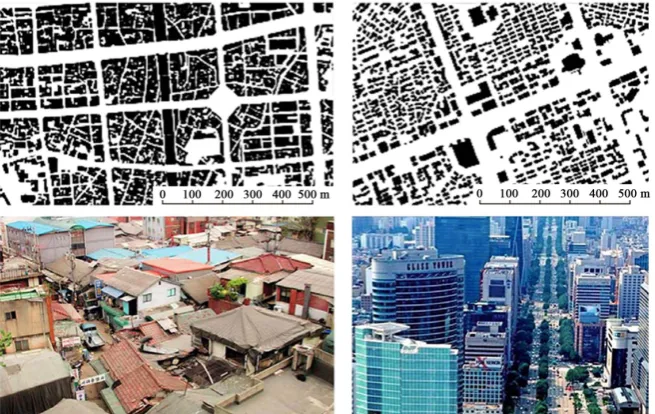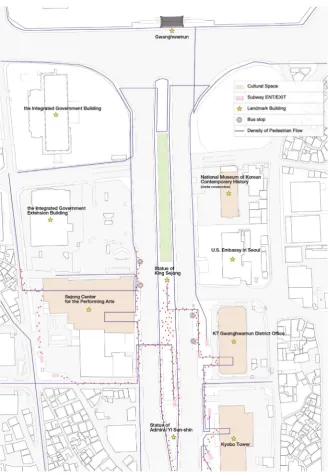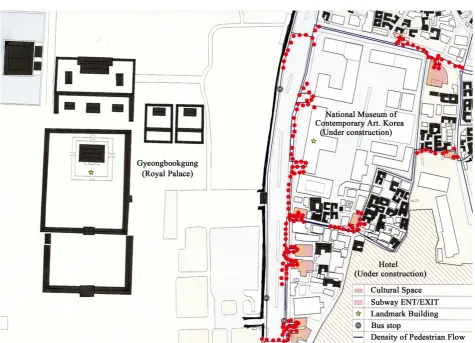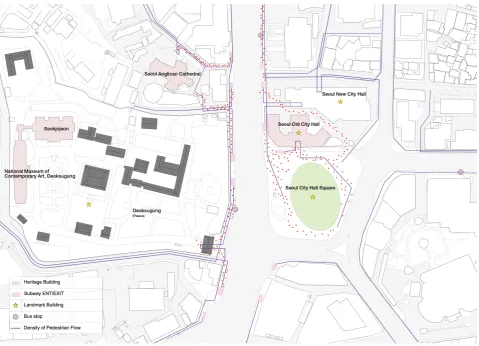ISSN Online: 2328-4919 ISSN Print: 2328-4900
DOI: 10.4236/cus.2017.53018 Sep. 1, 2017 332 Current Urban Studies
New Forms of Place-Making and Public
Space in Contemporary Urban
Development in Seoul, South Korea
Hee Sun (Sunny) Choi
Lecturer, Landscape Architecture, Hong Kong Design Institute, Hong Kong, China
Abstract
Place-making and its evolving role in urban design has become a major issue in setting the 21st century urban development agenda. A key aspect of this within South East and East Asia in particular is an apparent tension between global aspirations and local tradition in emerging states such as China, South Korea and Malaysia. The intention of this paper is to provide a better under-standing of how new place making can be incorporated in contemporary ur-ban development, particularly within this South East/East Asian context, so that the needs of local cultures can be sustained and developed, whilst ac-knowledging the desire of emerging states to gain international respect and recognition. The focus of this research is on exploring how these two views of design—the globally aspirational, and the locally situated and informed— might be reconciled, using the particular context of South Korea and the city of Seoul as a case study.
Keywords
Place-Making, Urban Transformation, Place Identity, Sustainability, Sustainable Social and Cultural Identity
1. Introduction
There is now a widely held belief (King, 2004; Werbner, 1998; Appadurai, 1996) that contemporary public space is defined by political, economic and technolo-gical advancements, with the issues surrounding public space directly linked to the politics and socio-cultural make-up of the local community, and how the si-tuated histories of places within cities and local society and culture intersect.
Within this context, the majority of recent South East and East Asian urban
How to cite this paper: Choi, H. S. (Sun-ny) (2017). New Forms of Place-Making and Public Space in Contemporary Urban Development in Seoul, South Korea. Cur-rent Urban Studies, 5, 332-347.
https://doi.org/10.4236/cus.2017.53018
Received: July 21, 2017 Accepted: August 29, 2017 Published: September 1, 2017
Copyright © 2017 by author and Scientific Research Publishing Inc. This work is licensed under the Creative Commons Attribution International License (CC BY 4.0).
DOI: 10.4236/cus.2017.53018 333 Current Urban Studies lation to the urban and economic growth that is occurring within South East and East Asia.
Considering that, the aim of this paper is to discover how new place making can be incorporated in contemporary development, using the case of Seoul in South Korea. Seoul is chosen as a particular reference case and example of a city with a historic core that has integrated new development on a significant scale, and as such can provide a physical reference for a theoretical review. The ques-tion that this paper addresses is how can place making contribute to the reten-tion and evolureten-tion of a sustainable built environment?
2. Methods
In order to understand the Sejong-ro case study area in Seoul, in relation to the retention and evolution of traditional cultures and the particular kind of place identity that is emerging, information was collected using a variety of methods. The primary method involved a series of semi-structured interviews aimed at gaining a clear insight into the perspectives of different key actors involved in the Sejong-ro project. The interviews focused on building up a comprehensive narr-ative of their knowledge, experience, and sense of identity and sustainability in new place making. The interviews were conducted with officials from government, local authorities, public and private producers, developers, non-governmental organizations, and residents. Other methods of obtaining information involved direct observations within the field, and gathering archival material such as gov-ernment documents, newspapers, previous research work and policy documents.
The research employed morphological and typological field surveys. The em-pirical study in Jongro, Seoul was carried out from April to December, 2012. Using William Whyte’s “The Social Life of Small Urban Spaces” (1980) as a key precedent, these research methods provide a means of gaining a deeper insight into practical questions and issues relating to local identity.
DOI: 10.4236/cus.2017.53018 334 Current Urban Studies and residents).
3. Seoul in Retrospect
[image:3.595.211.539.477.684.2]Seoul, the capital of South Korea, is situated in the northwest of the country. It is a settlement that has existed for over 2000 years. In the 14th Century it was es-tablished as the capital of Joseon, a sovereign state that preceded the formation of Korea. With Japanese colonial rule (1910-1945) came the development of a modernised public infrastructure and increased urbanization across Korea and in Seoul in particular. This evolution is visible in the street patterns of Seoul to-day, with the northern and southern sides of the city each having a particular morphological character. The southern part of the city that has grown up since the period of Japanese colonial rule has a recognisably rectilinear urban grid, whereas the northern part is more organic and diverse in character, and retains the layout put in place based on the principles of geomancy 600 years ago (see Figure 1).
Since the end of Japanese rule in 1945 Seoul has steadily grown in size as a consequence of urban migration and economic development. As the city has grown it has evolved from a linear city into a polycentric-core (multi-core) city of approximately 600 km2 in size, with a population of 10.5 million people with-in the city itself, and a population of 23 million withwith-in the wider metropolitan area (http://www.seoul.go.kr/)
The historical development of Seoul is thus recognizable in the characteristic building typologies from each period, with the traditional buildings that pre-date the Japanese colonization, the key buildings from the colonial period that have been retained, and the modern architecture that has grown up since Korean in-dependence (see Figure 2).
DOI: 10.4236/cus.2017.53018 335 Current Urban Studies Figure 2. Gyeongbuk Palace, originally constructed from 1395 onwards, (source: Kim, 2013); Bank of Korea, built in 1909, (source: Kernbeisser, 2010); Jongro Tower, built in 1999, (source: Author, 2012).
As described in Seoul urban development by Seon (2003), following the libe-ration and independence from Japan in 1945, Seoul experienced extremely rapid urban construction that further broke away from the traditional concepts of geomancy and embraced modern designs and international influences. Howev-er, detailed research into the history of the urban development of Seoul is hin-dered by the fact that through the period of Japanese colonization (1910-1945) and the Korean War (1950-1953) most of the historical urban development and policy documents relating to Seoul were burned or destroyed. Consequently the surviving documentation recording how Seoul has changed and developed is li-mited (Seon, 2003). Currently, only a small number of authors (Seon, 2003; Lee, 1994; Kim, 1991) have published accounts of Seoul’s urban development and transformation, based on the limited written history and oral accounts from government officials and private developers.
As international trade with South Korea grew during the period from the 1960suntil the mid-1980s, new buildings housing multi-national corporations became a dominant force in shaping and rearranging the urban fabric of central Seoul. These building types in Seoul demonstrate some repetitive contemporary characteristics that typify a commercial approach to built form production in-fluenced by capitalism, globalization and “positivistic technocentric rationality” (Harvey, 1990).
DOI: 10.4236/cus.2017.53018 336 Current Urban Studies movements as three chronological terms: “traditional culture”, “colonial culture” and “consumerism culture”. The current phase of the urban development of Seoul can be classified as the latter of these.
4. Creation of New Public Space and Erasure of Historic
Landmark Buildings
As part of this urban transformation, new design strategies and urban develop-ment concepts were introduced in 2010 for four major new developdevelop-ment corri-dors in the city even more future oriented but rooted yet, each with its own dis-tinct character; the historic corridor, digital media corridor, creative corridor and green corridor (see Figure 3).
This is an attempt by the planning department to utilize a coherent and sys-tematic approach to improve the built environment, in response to a period of growth within the centre of the city that led to a production of the built envi-ronment that resulted in the creation of “ambiguous” places of control and con-sumerism lacking in local identity and a sense of place.
Firstly at the digital media corridor, the urban transformation includes the creation of a new urban culture based on digital media technology within the CBD area of Seoul, aimed at creating a vibrant new urban environment through public and private partnerships fuelled by wireless communication and connec-tivity, and the regeneration of historic and cultural spaces around heritages sites (see Figure 4 and Figure 5).
[image:5.595.210.537.531.699.2]The second key axis within the new development plan, and the main focal point of this research, is the Historic Corridor (see Figure 5), centred around Sejong-no (named after Sejong the fourth King of the Joseon Dynasty, “no” meaning street). This wide boulevard is positioned to the south and on axis with the Joseon Dynasty Palace, of Gyeongbokgun. The Joseon Dynasty was the longest standing and most recent of the Dynastic periods in Korean history and the period within which the foundations of Korea were established. Knowing this, when the Japanese colonized Korea in 1910 this site was chosen as the
DOI: 10.4236/cus.2017.53018 337 Current Urban Studies Figure 4. View of Digital Media Corridor (Source: Author, 2012).
[image:6.595.228.525.239.662.2]DOI: 10.4236/cus.2017.53018 338 Current Urban Studies location of the Governor General Building of Seoul, completed in 1926 and oc-cupied by the Japanese colonial rulers of Korea until the United States received the Japanese surrender from this building at the end of the Second World War in 1945 (Yoo, 2010).
Following this, the building continued as government offices for the Korean Government for a further 40 years, until 1982 when it was converted to a mu-seum and opened to the public. Over this period the building and what it represented continued as a topic of much debate in relation to the modern iden-tity and history of South Korea. In 1996 the Korean Government reached the decision to demolish the building. For many South Koreans, although there were changes of occupation in the intervening years this building continued to sym-bolize the period of Japanese rule and some welcomed the demolition. But for many others, particularly amongst the younger generation the building was an important landmark. This view was underlined by the focus group meetings and workshop conducted with local users in Seoul; when asked the question what for them symbolised Seoul’s identity, a number of participants referred to the for-mer Governor General Building.
Reviewing the process of the decision to demolish the colonial building was partly inspired by the desire to erase the memory of the Japanese colonial era, and partly inspired by a wish to restore the visual symmetry and appearance of the Sejong-no Boulevard, Gate and Palace beyond (see Figure 6).
[image:7.595.249.499.503.674.2]With the demolition of the Governor General Building at the northern end of Sejong-no complete, the Historic Corridor design proposals include a renova-tion of the boulevard itself, with the central reservarenova-tion updated to include water and landscape features and new paving. This boulevard is a destination for tour-ists and for certain national celebrations when the 8 lanes of traffic are closed, the 600 metre long boulevard is transformed into a 100 metre wide pedestrian processional space (see Figure 7).
DOI: 10.4236/cus.2017.53018 339 Current Urban Studies Figure 7. Views of new public space along Sejong-no and Gyeongbok Palace (Source:
Yoo, 2010).
This redevelopment, with its focus on the creation of a pedestrian-friendly en-vironment and sustainable enen-vironmentally friendly public open space, can be considered as an “eco-cultural” approach to place-making, defined by Abel (1997) as a form of cultural emancipation and a counteraction against the draw-backs of modernized market-led approaches to urban form.
However, as noted by R. King (2009), the erasure of the old traditions in Ko-rean urban development has currently left behind a vacuum in urban develop-ment. Using the case study site of Sejong-no in Central Seoul, and considering the arguments put forward by Abel in defining an “eco-culture” that is influ-enced by market-led approaches and the observations by Ross and others in re-lation to the urban development of Seoul, the case study research included direct observation of Sejong-no as a means of testing these theories and how they can be operationalized on the ground. This clarified the land use and the architec-tural typologies that exist within the Sejong-no and Samcheong-dong area. An imposing gateway to Seoul’s CBD, the central Boulevard of Sejong-no stands in contrast with the cultural area of small traditional lanes that are set back from the large commercial blocks on the main street. It is within this network of smaller scale streets that a creative and cultural community is growing, full of art galleries and small commercial enterprises, with traditional and contemporary building types that reveal an evolving social and cultural network.
DOI: 10.4236/cus.2017.53018 340 Current Urban Studies Figure 8. Sejong-no: Spatial analysis with cultural activity (Source: Author, 2012).
The spatio-functional analysis and observations above are supported by street level views taken from the Samcheung-dong and Sejong-no areas (Figure 10 and Figure 11).
DOI: 10.4236/cus.2017.53018 341 Current Urban Studies Figure 9. Samcheong-dong: Spatial analysis with cultural activity (Source: Author, 2012).
Figure 10. Samcheong-dong (above) (Source: Author, 2012).
[image:10.595.230.517.586.697.2]DOI: 10.4236/cus.2017.53018 342 Current Urban Studies they give a great sense of character and identity for a city, and offer the chance for surprise discoveries for visitors”.
Another user commented “I prefer this as I like undulating and hilly towns more that flat ones. I get a better sense of place when I can review the hills around.”
This rooted cultural and social activity stands in contrast to the new develop-ment along the boulevard of Sejong-no, the large central strip of public, pede-strian-only space is currently underused and lacking in this activity and vitality. It is the view of certain planners, such as those overseeing the development of the central boulevard in Putrajaya, Malaysia, that informal usage and creative occupation of public space along central boulevards serving public offices is in-appropriate (Choi, 2011). The planners of Putrajaya feel that the central boule-vard should be reserved for national festival activities. However, there is a dan-ger that this reserved approach to place-making becomes, to quote Stern and Hall (2010), “disassociated from current residents, their needs and activities, and the infrastructure that supports those needs and activities.” The feedback from the 21 participants in the interview process, including members of the Seoul planning department, have revealed how the urban policy for each region is only geared towards commercial growth and increasing the international competi-tiveness of each region, rather than focusing on localization.
Frampton (1985) argued that modern architecture should engage with and respond to its particular context, in order to revive the old and enrich the new, resulting in an evolving and sustainable sense of place identity.
DOI: 10.4236/cus.2017.53018 343 Current Urban Studies building that was built during the period of Japanese rule. The classical details of columns and portico echo the traditional hierarchy that still exists within the successive “republics” of South Korean rule. A recent addition to the govern-ment buildings in Seoul is the new President’s office (see Figure 12, in back-ground). The existing colonial building retains a rooted sense of place whilst the new addition represents a future-orientated approach to providing a new identi-ty.
The interpretations of such identities in architectural built form are connected to the wider issues of society and the public realm, and at a more intimate level relate to materiality and human experience. In a semi-structured interview with Lim, a local resident, when questioned about the changing usage and perception of the area, she commented “I have been living here since the Korean-Japanese War. Some of the local housing has been converted to hotels and many tourists come to see our traditional way of life and atmosphere. The way we live our lives is how it has been for generations.” These comments highlight the particular sense of place that exists within Seoul.
[image:12.595.210.539.519.682.2]In addition, cultural identity includes social activities that provide relation-ships between public space and users’ activities, enhancing a sense of place. In Seoul, there are many cultural and historical events, festivals and public perfor-mances, engaging inhabitants and visitors and encouraging their participation. From the workshop meeting with Seoul residents these events and festivals were highlighted as a key element of the city’s identity.
DOI: 10.4236/cus.2017.53018 344 Current Urban Studies The participants further stated that the retention of historical and memorable built form in urban development is something they valued. Especially, the reten-tion rather than demolireten-tion of heritage buildings can embody users’ memories and sense of time and place, encouraging an evolving form of cultural usage and activity and informing the creation of a particular kind of local identity. The spatial analysis and assessment of cultural activity shown in Figure 13 illustrates how the traditional built form of the Old City Hall and the contemporary New City Hall have been supplemented by a new form of public space to the south, within which space has been reserved for evolving forms of cultural usage.
[image:13.595.60.540.291.637.2]This understanding of the local identity of Seoul urban development high-lights how the new design approaches to the area are concerned and focused with the creation of the hard tissue of building form within the context of the soft tissue aspects of cultural identity and community engagement, in order to empha-sise continuity, distinctiveness, and self-esteem (Twigger-Ross and Uzzell, 1996),
DOI: 10.4236/cus.2017.53018 345 Current Urban Studies “aesthetic” functions in complex built form are inseparable, and that physical patterns may have predictable effects in culture, with its value and social struc-ture.
6. Conclusion
Reviewing the sustainable environmental, social and cultural urban development taking place, it is important to give consideration to the new forms of public space and place identity being created in response to global forces or transna-tional urban changes.
A critical understanding of the urban transformations of the public open space around Sejong-no, including the demolition of the colonial Governor General Building and the creation of a pedestrian friendly environment, gives a transferable lesson when considering the tension between political power and socio-cultural space in place making.
The evolution of the cultural and political identity, street pattern and the nat-ural landscape within Seoul in particular highlights the way in which the new place making can be established and commence its own period of evolution. As the political identity of the government seat in Seoul shifts from a traditional identity to something new and less identifiable, the new public space created can sustain and evolve local identity only if it can be accepted and understood by residents and users in relation to their social and cultural context and structure. This shows the importance of how changes in the economic system and the po-litical system influence the transformation of cultural institutions and practice in place making (Rapoport, 1977).
The local identity created is not that of a fixed, perfect state but rather an evolving one that responds to changes in the form production process in relation to its social, cultural, and political context in each city. The value of local identity in the development of a city’s social structure and physical form is an important and evolving part of urban design thinking and ideology, in relation to the value of locality and social and cultural context.
As discussed, place-making is defined not simply in terms of physical aspects, but also through an understanding and appreciation for cultural processes, whe-reas the creation of local identity can be clearly interpreted as a political act, not inspired by a desire to create a particular sense of locality but by political ambi-tion.
DOI: 10.4236/cus.2017.53018 346 Current Urban Studies interrelationships between historical spatial structure, human perceptions and social patterns, so that an appropriate balance of usage can be achieved, the area’s unique character maintained and a diverse new range of cultural activities sustained.
In closing, this paper has helped to explain how the case of Seoul can contribute to the establishment of local identity for 21st century contemporary urban de-velopment in South Korea and the wider Asian region. This stresses that in place making it is crucial to acknowledge the cultural, political, and economic context, in order to create not only distinctive design qualities with sustainable built form, but also a progressive design ideology and an evolved urban design frame-work for a “better loved”, forward looking, locally and globally sustainable city.
References
Abel, C. (1997). Architecture and Identity: Towards a Global Eco-Culture. Oxford: Architectural Press.
Appadurai, A. (1996). Modernity at Large: Cultural Dimensions of Globalization. Min-meapolis: University of Minnesota Press.
Choi, H. S. (2011). Transcription Files in Possession of Place-Identity in 21st Century New Town Development. Ph.D. Dissertation Appendices, Oxford: Department of Built Environment, Oxford Brookes University.
Frampton, K. (1985). Modern Architecture—A Critical History. London: Thames and Hudson.
Fraser, N. (1992). Rethinking the Public Sphere: A Contribution to the Critique of Ac-tually Existing Democracy. In C. Calhoun (Ed.), Habermas and the Public Sphere
(pp.109-142). Cambridge: MIT Press.
Harvey, D. (1990). The Condition of Postmodernity: An Enquiry into the Origins of Cul-tural Change. Oxford: Blackwell Publishing.
Kernbeisser, K. (2010). Bank of Korea.
https://www.flickr.com/photos/kernbeisser/3075738499/in/photolist-5FMXU8-RfFoMj -q98gtG-6PenZv-VBq8ux-SHbwdQ-8cGcZK-s6nSt-VtttzL-U5SGHW-9J2yaS-9HZ3Yk -6tKpWo-6jZMQ7-9HYAUv-5LbMPm-VBq9or-s6o7j-HjV8eF-VBq3KH-V2fJxh-6jVD qK-V2fK6S-fpAMo3-5kuRC3-93D5o-VBq6Mz-8VCX1k-6jVJMZ-baAPK-5FS85G-7s7 Aeh-skMg1W-9jwceT-U8q44k-Uipy6n-Ui6as2-fuDXoN-hjJT9N-abCwRX-WebpEq-7t owUA-baANE-s6o4S-VBq6DD-KvjZR-5LbMK9-baAPt-cNoScN-8dzEbP
Kim, B. (1991). Openness and Cultivation. Seoul: Moonji Publishing. Kim, D. C. (2013). https://pixabay.com/en/users/olmusician-2219832/
King, A. D. (2004). Spaces of Global Cultures: Architecture Urbanism Identity. London: Routhledge Publishing.
King, R. (2009). Seoul, Conditions of Possibility, and the Postnational Hyperspace. Envi-ronment and Planning D: Society and Space, 27, 616-632.
https://doi.org/10.1068/d5908
Lee, M. H. (2012). Seoul Map Analysis and Analysis of the Public Usage. Seoul: Seoul Na-tional University.
DOI: 10.4236/cus.2017.53018 347 Current Urban Studies
Seoul Metropolitan Government (2010). Seoul History. http://www.seoul.go.kr/ Stern, P., & Hall, P. (2010). Historical Limits: Narrowing Possibilities in ‘Ontario’S Most
Historic Town’. Canadian Geographer, 54, 209-227.
https://doi.org/10.1111/j.1541-0064.2009.00296.x
Twigger-Ross, C. L., & Uzzell, D. L. (1996). Attachment and Identity as Related to Place and Perceived Climate. Journal of Environmental Psychology, 25, 207-218.
Werbner, P. (1998). Negotiating Public Space: Strategies and Styles of Female Domestic Workers in Singapore. Urban Studies, 35, 583-602.
https://doi.org/10.1080/0042098984925
Whyte, W. H. (1980). The Social Life of Small Urban Spaces. Washington DC: Conserva-tion FoundaConserva-tion.
Yoo, S. (2010). Views of New Public Space Sejong-No and Gyeongbok Palace, Korea-Japan 100 Years on—Efforts to Correct Wrongs Done by Japanese. Seoul: Korean Herald. Zukin, S. (1991). Landscapes of Power: From Detroit to Disney World. Berkeley, CA:
University of California Press.
Submit or recommend next manuscript to SCIRP and we will provide best service for you:
Accepting pre-submission inquiries through Email, Facebook, LinkedIn, Twitter, etc. A wide selection of journals (inclusive of 9 subjects, more than 200 journals)
Providing 24-hour high-quality service User-friendly online submission system Fair and swift peer-review system
Efficient typesetting and proofreading procedure
Display of the result of downloads and visits, as well as the number of cited articles Maximum dissemination of your research work









